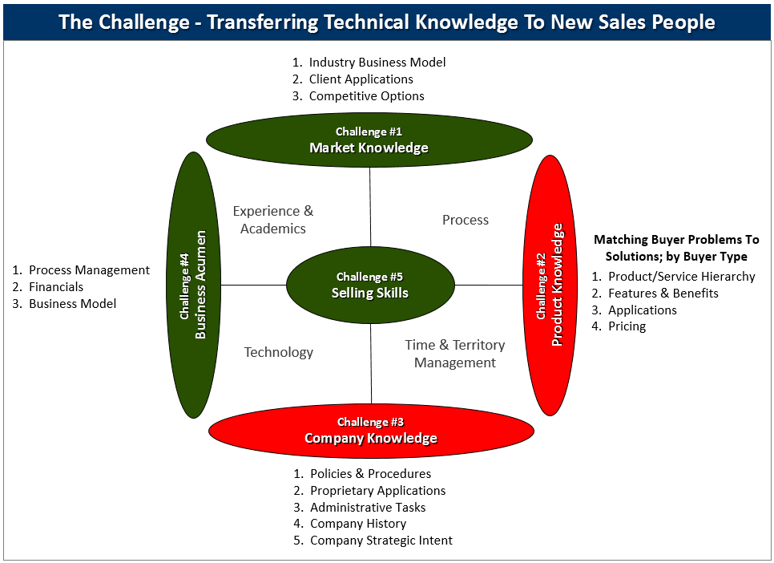TheNaviGuide™ for Onboarding
A visual knowledge transfer tool used by trainers and product managers to onboard new sales people
The New Sales Person Onboarding Challenge
“Why is it taking so long to get new salespeople trained, making sales calls and closing deals?”
Getting new salespeople to immediately make sales calls, work sales opportunities, and close deals to cover their cost is one of the main stumbling blocks when it comes to building sustainable revenue growth year-after-year. It’s expensive and time-consuming because it takes to long to review, translate, memorize and master:
- Product and service information
- Applications and solutions
- Pricing models
- Sales call approach i.e. presenting the right questions and answers at the right time during sales calls


TheNaviGuide™ for Onboarding Sales People Solution solves this problem by providing salespeople with a facilitation tool that visually presents an interactive decision tree – – across all stages of the sales call – – to provide the buyer and the seller with live-time, instant access to the right:
- Questions to ask at the right time to pinpoint the buyers highest priority challenge
- Explanations, demonstrations, and/or solutions to present to the buyer at the right time
- Recommendations, pricing, and proposals to present at the right time
- Objection handling techniques and information to present at the right time
- Support documents to present at the right time
- Application of sales call best practices, lessons learned and general selling skills i.e. SPIN, Consultative, Challenger, Solution Selling and most other sales techniques
TheNaviGuide™ for Onboarding
- Cuts in half the time required for new sales people and partners to begin making sales calls, generating opportunities and closing deals
- Nearly eliminates the time required for new sales people and partners to review, translate, memorize and master information, including sales call approach, product and services, industry and buy-point applications, competitor comparisons, as well as pricing and proposal models
- Eliminates distracting product, market, pricing,
and other technical experts to train salespeople


What’s Causing Onboarding Failure?
The short answer is that the onboarding tactics being deployed are not getting sales people to make sales calls, generate sales opportunities and close deals quickly enough to cover their cost, including:
The short answer is that the onboarding tactics being deployed are not getting sales people to make sales calls, generate sales opportunities and close deals quickly enough to cover their cost, including:
- Hiring seasoned industries experts
- On-the-job training
- Conducting instructor-led training sessions
- Providing social collaboration tools and messaging
- Assigning coaches/mentors to make joint sales calls, ride-along and review call recordings
- Building sales libraries and knowledge management systems
- Role-playing to rehearse sales call execution
- Providing eLearning tools for self-paced training
- Creating sales playbooks, Wiki’s, FAQ’s and scripts
- Scheduling interviews, lunches, meetings and hands-on training with technical experts
Traditional Onboarding Tactics Have No Direct Impact
The above tactics are important to the success of onboarding new salespeople but they do not have a direct impact on solving the time challenges faced by new salespeople as they rush to study, translate, memorize, rehearse and master the volume:
- Questions to ask to understand and prioritize the buyers wants and needs
- Explanations to demonstrate solutions, products, services, features, functions, and benefits
- Formulas and calculations required to create the right pricing and proposals
- Negotiating points to close deals
- Objection handling tactics across all steps of the sales call
- Market knowledge i.e. industry, department, process, etc.
- Competitor knowledge i.e. unique differentiation, comparison points
- Application of general selling skills i.e. presenting, listening, negotiating, etc.


What’s Missing From Traditional Onboarding Tactics?
The onboarding tactics above do not specifically address the challenges faced during each of the five sales call steps above as both the buyer and the seller struggle to exchange information with precision – – effectively, efficiently, and predictably, including:
- Select the right questions to ask, answers to give, statements to make, documents to show
- Present the right sequence of questions, answers, statements,
and documents at the right time - Avoid over or under explaining details
- Receive and review the questions, answers, statements, and documents presented
- Accurately interpret, clarify the questions, answers, statements, and documents
- Memorize and recall the questions, answers, statements, and documents
- Validate receipt and understanding of questions, answers, statements, and documents
- Evaluate the impact/relevance of the questions, answers, statements, and documents
- Test for agreement on the right next steps based on the information communicated
Once Built TheNaviGuide™ For Onboarding Instantly Solves Multiple Other Problems At No Additional Cost:
Sales Managers and Trainers to:
- Train new salespeople in days and weeks rather than months and years on how to execute sales calls
- Refresh existing salespeople in minutes and hours rather than days and weeks on best practices
- Equip under-performing salespeople during their performance improvement plan (PIP)
Technical experts (i.e. product, market, pricing and marketing managers) to:
- Communicate to salespeople changes made to the sequences of conversation topics, questions, answers, statements, and documents
- Communicate to salespeople changes made to p
roducts , services, features, benefits, applications, pricing models, unique differentiation and competitive comparisons - Use sales conversations for qualitative market research
- Launch new products
Entrepreneurs & Executives to:
- Launch and expand a sales team by enabling new sales leaders, salespeople, and affiliate partners to immediately begin executing sales calls and closing deals without distracting technical experts
- Improve a sales team by enabling existing salespeople and affiliate partners to cross-sell, up-sell and renew existing buyers, sell new buyers, and win-back past clients
- Merge sales teams by focusing existing salespeople from both sales teams on cross-selling each other’s offerings while C-level executes sort out the post-merger organization

